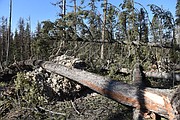Windstorm causes massive blowdown
An extreme windstorm that blew through the north end of Whitefish Lake has left hundreds of trees on the ground, but the state Department of Natural Resources and Conservation is making plans to salvage the timber.
Dave Ring, Stillwater State Forest unit manager, said the first priority will be to remove trees blocking the roads, and then plan for a timber sale that would eventually remove the fallen timber.
“We are going to do something with it,” Ring said. “It’s not going to go to waste.”
The windstorm on March 14 blew down trees along East Lakeshore Drive, Lower Whitefish Lake Road, between King Creek and Brush Creek, in a large swath of area between Smith Lake and East Lakeshore Drive and Whitefish Lake.
DNRC is estimating that up to 500,000 board feet of timber may be salvaged from the downed trees that resulted from the windstorm.
Most of the trees that were blown down are Douglas fir or ponderosa pine, while larch in the area seem to be mostly unscathed. Most of trees were uprooted during the storm indicating that they were healthy, but the speed of the wind toppled them.
“It seems like the wind speed and the path it followed off the lake is what caused this,” Ring said.
The Whitefish Legacy Partners is advising that the Whitefish Trail at Swift Creek and Smith Lake are currently impassable and trail use is not advised. The Smith Lake Disc Golf Course, which is still closed until May 1 under its permit, is also covered in downed trees.
Lower Whitefish Lake and the West Smith roads remain closed due to the downed trees. In addition, the Swift Creek snowmobile trail access is closed.
Currently, Flathead County has roads closed to heavy truck traffic because of spring break-up. Road crews were out working along East Lakeshore Drive last week to remove trees that had fallen on and along the road.
Ring said as soon as the closure is lifted, then DNRC will be able to access the state forest roads to remove the downed trees.
DNRC has closed the area to public firewood gathering. The goal, Ring notes, is to save the trees for a timber sale project that would generate more revenue for the State Trust. Early estimates are that up to 100 truck loads of timber could be salvaged and at $1,000 per truck load that would generate significant money toward the Trust Land Management division mission of managing trust land resources to produce revenues for trust beneficiaries while considering environmental factors.
State Trust Lands produce revenue while being open for public recreation and commercial recreation through licenses. The lands are managed for the benefit primarily of K-12 schools along with Montana universities, the school for the deaf and blind and the Montana Veterans Home.
DNRC is expecting as soon as possible to begin the process to evaluate the area for a timber sale. All timber sales are developed, analyzed and reviewed by specialists under the Montana Environmental Policy Act.
Ring said the MEPA process will involve coordinating with DNRC’s recreation partners in the area including the City of Whitefish and Whitefish Legacy Partners for the Whitefish Trail and the Whitefish Disc Federation regarding the Smith Lake Disc Golf Course.
Additional sections of the Whitefish Trail are also planned in the area, so logging work would likely include timber harvest methods designed to minimize visual impacts accommodating for the future trail corridor. The area is also part of the Whitefish Neighborhood Plan so that will be factored in to the evaluation.
“There would also be public input on the process,” he said. “There’s a number of factors to consider.”
The timber sale would likely meet the requirements for a MEPA categorical exclusion, meaning that a full environmental assessment wouldn’t be required before the timber project would go before the state Land Board for approval and then go out to bid.
Ring said the goal would be to have the project ready for work by late June.
“The longer the trees sit the more likely it is that beetles could move in,” he said. “We don’t want the trees to sit through July because they will begin to lose value the longer they sit as they become less ideal for lumber. We want to work quickly so that when the June rains stop it’s ready to go.”
For more information, contact the DNRC Stillwater Forest at 406-881-2371.








